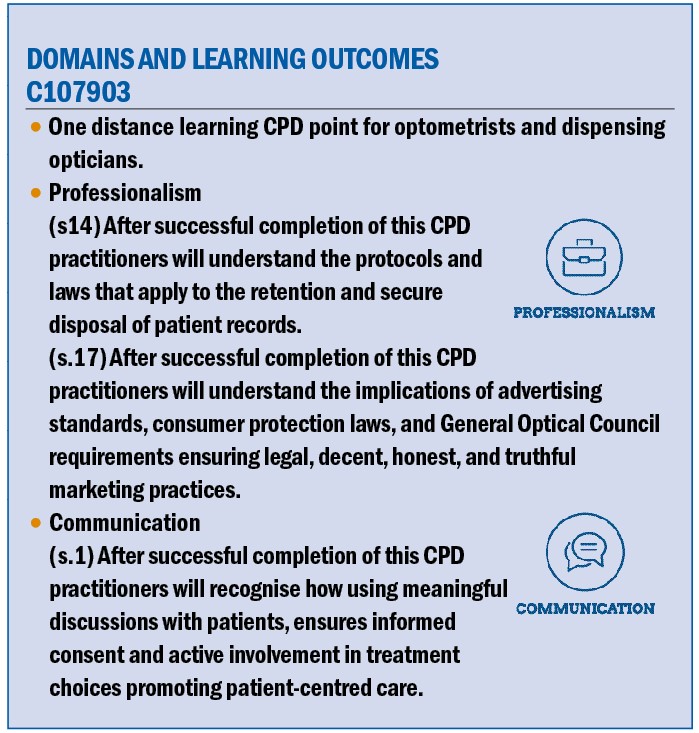
Following on from the previous article on internal practice communication, we will now turn our attention to external communication.
This CPD article will attempt to navigate through the multiple ways practices have of communicating with existing patients, how they might attract new patients, practice management systems and recall, website design, and the huge number of social media channels that a practice may consider using to enhance their presence to a new audience.
It is also essential to ensure compliance with laws, and General Optical Council (GOC) regulations that apply to individual and business registrants regarding all marketing communications.
The Advertising Standards Authority (ASA) is the UK’s independent advertising regulator, the Committee of Advertising Practice (CAP) write the advertising codes, the fundamental principle of marketing advertisements is that they are legal, decent, honest and truthful.1
ASA/CAP are recognised as an established means of consumer protection by government, Trading Standards, and the courts for non-broadcast marketing communications. The UK code of Broadcast Advertising Code (BCAP) applies to teleshopping, promotional television channels, television text, interactive television advertisements, programme sponsorship on both radio and television.
Social media is a growing area for marketing communications which is also subject to the same laws and regulations contrary to the belief that as it is not printed, on television or radio it is exempt from law and regulation.
Advertisements must follow the CAP or BCAP code also the Consumer Protection from Unfair Trading Regulation 2008 (CRPs),2 which prohibit unfair, misleading and aggressive commercial advertising practices.
Additionally, the Consumer Rights Act 2015 (CRA)3 is clear on the description of goods and that they are fit for the intended purpose to avoid any breach of regulations the content of all marketing communications should be considered carefully as the consequences of breaking these rules can be damaging to business reputation, costly if a fine is levied and even involve a custodial prison sentence.
In 2015, Boots Opticians faced complaints about its misleading advertisements relating to the harmful effects of blue light, upheld by the ASA stating the advertisements were misleading and unsubstantiated. They were also the subject of a BBC Watchdog show.6 Boots Opticians was sanctioned by the GOC and fined £40,000. This is not a situation that any business would wish to face.
In 2022, Templeman Opticians was found to have breached ASA’s CAP codes within its website due to misleading claims that visual stress caused dyslexia and that it could formally test for and diagnose dyslexia,7 this highlights the need the need to ensure all marketing communications comply with the ASA codes, CRPs, CRA and GOC regulations.
Enforcement of a breach in CPRs and CRA is by the Trading Standards and Competition and Markets Authority (CMA) (see tables 1 and 2.).
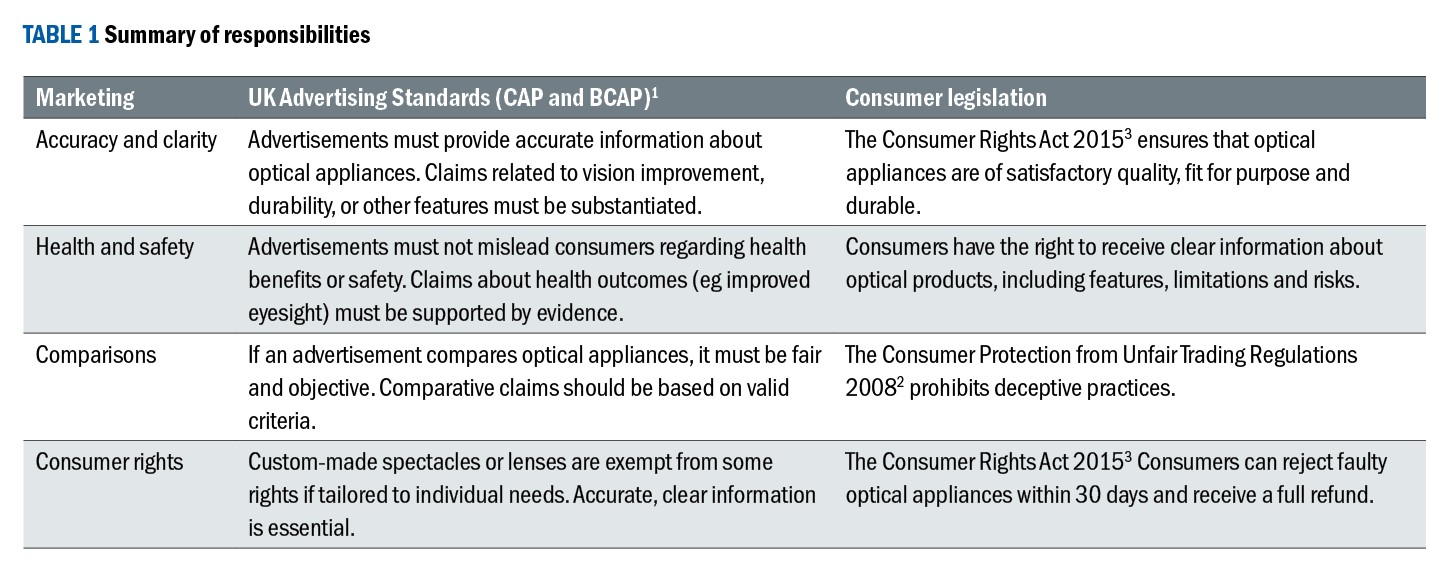
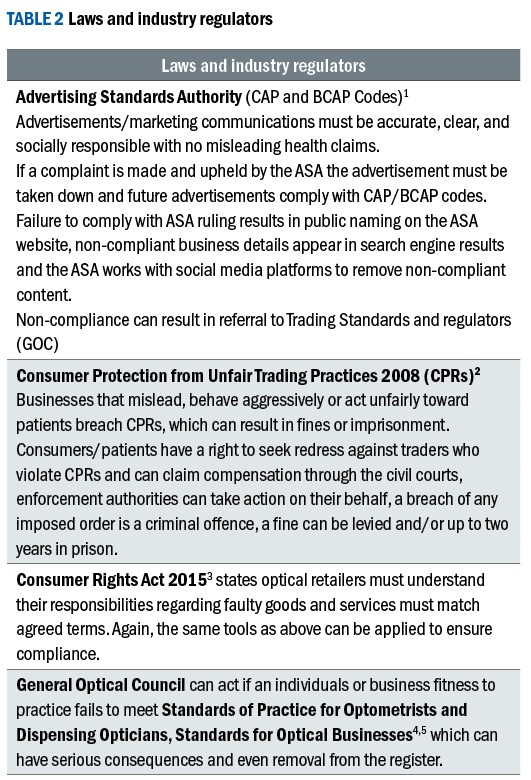
Marketing is an essential part of every business, opticians are healthcare professionals, but also need to create, maintain and expand their patient base to ensure a business is economically viable as well as delivering a high level of patient care.
Why are existing patients important?
While any company cannot hope to grow without acquiring new patients, the value of your existing patients should not be underestimated.
Over many years business analysts have reported that it costs much more to attract new patients than retain existing ones – this is not true only in the optical sector, but bears out across many sectors – the Harvard Business Review suggests, depending on the industry, ‘it may cost as much as five to 20 times as much to attract a new customer than it does to retain an existing one’.8
Demographics also come into play; with an ageing population most practices may also want to consider a strategy for attracting new patients to replace natural attrition. Patients leave practices for many reasons, such as relocation, difficulties in attending the premises, dissatisfaction with services, trying the new practice that has opened in town, or sadly they may be too ill to attend or ultimately die.
Existing patients within optical practice are often loyal and have been satisfied, some for many years with the services and products offered, they may find the practice convenient and their whole customer journey is acceptable to them. It clearly costs less to maintain existing patients as they have already ‘bought into’ your brand and you do not have to spend much (if any) of the advertising budget on them.
Keeping existing patients within your practice pays dividends, you already have a relationship with them, and as such they trust you and are reliant on you to look after their ocular health clinically and make the most of their vision by offering suitable advice and products. Optical practices should endeavour to tailor their offerings, both clinically and technically, to each individual patient.
Research as far back as 2005 by Fylan et al.9 suggested that patient care and consultations should be tailored to the individual needs of the patient, meaning patient-centred care.
Even earlier, Coulter10 suggests that rather than the practitioner making decisions in the best interests of the patient, ‘patients have grown up’ and should be treated as partners, which includes discussing all aspect of their care and treatment options – working together to achieve the best outcome.
In fact, this is part of GOC Standards of Practice (s1). Listen to patients and ensure they are at the heart of the decisions made about their care.11
How might you attract new patients?
There are multiple ways an optical practice may attract new patients. The first thing is to decide what your message is – what do you want to say? After that is decided, consistency is important.
Keeping the message consistent shows uniformity, especially across different channels. Simple channels may be a poster in your window, a tag line on an advertisement in the local paper, or digitally via website, or on social media channels.
Above all – keep it simple and keep it consistent. Any marketing done should make you stand out from the crowd; showcase your expertise and what value you can offer to your potential patients.
The optical sector is changing at a pace we have never seen before, as highlighted in a report commissioned by the GOC in 2014.12 This report saw a whole section dedicated to the changes within society and another on the changes in consumer behaviour and marketplace changes.
Before embarking on any marketing activity, a thorough assessment of the target audience and objectives should be carefully considered, otherwise any effort expended on this activity may not realise the success envisaged.
Strategy for attracting new patients
Marketing and sales are often not words we would associate with an optical practice, however, most high street optical practices are somewhat unique in the fact that they deliver clinical services and optical products.
At its most basic, an optical practice whether a small part-time independent or large corporate ‘super optical’ is a business, and as such needs to (at the very least) break-even to continue.
Many other professions deliver only clinical services – think of a traditional or ‘brass plate’ dental practice or doctors’ surgery, often located above a retail outlet with no ‘shop frontage’, or within a home, or tucked down a back street with poor access – a far cry from the health hubs of today and optics is the same.
While marketing may seem totally alien to some practitioners, it is not vulgar or crass, it is a necessity of modern-day optical practice. This said, however, the marketing of services and product are very different, and practitioners should be mindful of this.
Multiple textbooks have been dedicated to this subject and can be found in the business section of any library.
Five key points to consider:
- Identify your target audience – this will help align the marketing strategy to what will appeal to the audience.
- Identify what you will promote – it is important to identify what is to be promoted. If it is too niche the point may be missed, or it simply does not appeal to those you are marketing too.
- If you decide to market product, be aware of stating prices. Price is a driver for many people and may make the difference whether they buy from you or not, however, value for money is often a more appealing concept to purchasers – a good product at a fair price often wins the race rather than rock bottom or high-end pricing.
- Identify what channels you will use to market and promote – will you use print advertisements, television commercials, social media platforms or online ads? Each type of marketing has its own advantages and disadvantages, so it is important to choose the one that will work best for your business. Also, do not underestimate the power of intangible advertising – word of mouth is often such and difficult to quantify!
- Do not lose sight of your goal – ultimately the goal is to increase awareness of your practice and increase revenue.
With any targeted campaign the goal is that your business goals are achieved and there will be an improvement in the optical practice performance.
It is equally important that you evaluate the results of your efforts – there is little point in investing in a marketing campaign if you do not monitor the returns on your investment, and an assessment of what worked well and what did not work so well.
This insight is invaluable for forward planning and subsequent campaigns.
Practice management systems (PMS) and recall
Many optical practices utilise the services of a PMS, which is essentially a database management system. A quick trawl of the internet shows there are literally dozens to choose from and each practice will choose a system that works for them.
Some practices maintain patient records on paper, a system utilised by all before the advent of computers and PMS, which works well, if perhaps a bit more labour intensive.
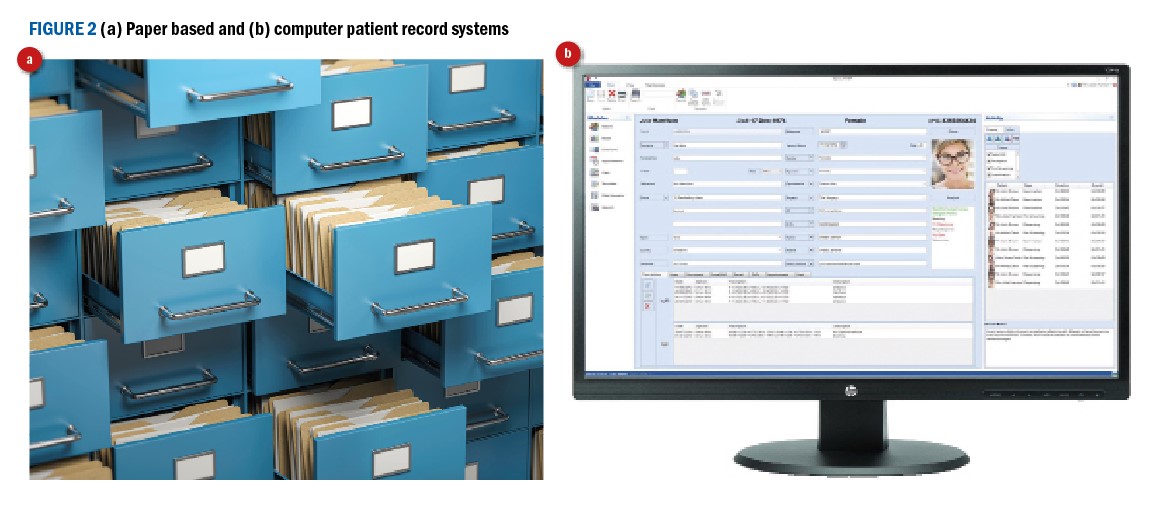
Regardless of how patient information is stored, the same caveats apply – all patient notes must be accessible for all those involved in the patient’s care13 and kept in a safe and secure manner14 and only disposed of when no longer required in accordance with the GOC Standards of Practice.
Additionally, regardless of how patient records are kept they must also be maintained and retained for the requisite time and in accordance with Data Protection Act 201815 and guidance from the College of Optometrists16 and Association of British Dispensing Opticians17 (see table 3).
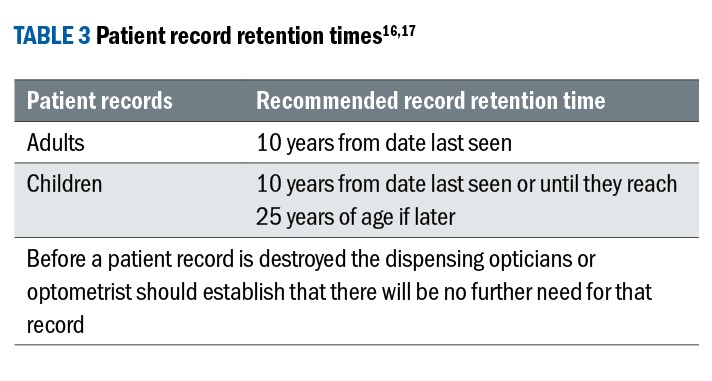
Many features of a PMS automate certain functions that a manual system simply would not be able to do without resources such as paper, envelopes and postage and a significant investment of time.
The key functions of a PMS include:
- Patient information
- Scheduling of appointments (diary function)
- Pre-registration of appointments including NHS eligibility, health conditions and often lifestyle questionnaires
- Clinical consultation recording including recall category
- Dispensing recording
- Ordering of any products – linked directly to laboratory or supplier
- Financial transactions
- Ability to link to NHS platforms for digital GOS claims
- Ability to link to direct referral to secondary care/ local
- pathways
- Miscellaneous free form box to record conversations, repairs, phone calls, advice given etc
All these features will allow a practice to target existing patients with specific offers or reminders. This of course ensures existing patients are well looked after, however, a practice must look externally to attract new patients and hopefully retain them.
When locum optometrists or dispensing opticians work in a practice for the first-time training should be given on the functionality of the PMS as they must be able to access all clinical notes quickly and efficiently – some systems have pop up notes that are particularly useful for highlighting direct issues of concern like patient safeguarding.
Whatever the system whether paper records or PMS it is essential that detailed clear concise patient records are kept, whether it is part of the eye examination or dispensing both are clinical assessments, and notes should be completed to same standard.
Website Design
The design of a website for any optical practice is one of the most important aspects of showcasing who you are and what you do – it could be considered as your digital ‘shop window’. Just as the design and layout of the physical practice is an expression of your ethos, values and mission, indeed your ‘brand’, your website should echo the same ethos, values and mission.
The design of the website should keep in mind your target audience and should ensure that it provides a good user experience – ie it should be easy to navigate. The website should reflect your physical brand and everything that it stands for – the two should be aligned. The website design elements, like colours, fonts, images etc, all form the brand identity. Therefore, these elements should be selected carefully and kept consistent across the website.
One great example of this is the Coca Cola company – their website depicts the iconic Coca-Cola bottle and their trademark red colour– keeping the message aligned to ensure the viewer has no doubt they are viewing the correct page.
Colour should be consistent across the physical practice and the website – if the practice already has a logo, then this too should be incorporated into the website. Different colours invoke different feelings too – colour psychology is a whole field of science where researchers show how colour affects perception and behaviour.18
Layout is of equal importance, the simpler the layout then the simpler the website is to navigate. This helps to draw attention to the important parts. The menu should also be easy to navigate with sufficient ‘drop downs’ to access the points the user needs. Excessive choice makes the website cluttered and clunky.
Fonts and typography are also important.
It should be clean and easy to read
Accessibility is another aspect to consider. It will not only make the experience better for your audience but is also required by law. Therefore, it would also be worth thinking about having a larger sized font available for patients and prospective patients who may have poorer visual acuity or consider also including alt text descriptions to allow access to a larger demographic.
(Alt text is alternative (alt) text and is meant to convey the ‘why’ of the image as it relates to the content of a document or webpage. It can be read aloud to users by screen reader software, and it is indexed by search engines. It also displays on the page if an image fails to load.)
Website navigation is key. The ultimate goal of anyone visiting your website is to quickly find the information that they are looking for. The more user-friendly the website is, the more likely it is that people will engage with the content and take the desired action.
Website design is an important matter and should not be taken lightly. A well-designed website can help form a good impression on prospective customers. It can also help nurture leads and convert these to loyal customers. But, more importantly, if it provides good user experience it will help visitors to the website access and navigate the website with ease.
Social Media Platforms
Where to begin? Today we are faced with a plethora of social media platforms, or as the cool kids call them ‘socials’. What platforms a practitioner chooses to use will depend on what they want to achieve.
The term ‘social media’ (SM) was first used in 1994 on a Tokyo online media environment, called Matisse.19 It was in these early days of the commercial internet that the first SM platforms were developed and launched. Over time, both the number of SM platforms and the number of active SM users have increased significantly, making it one of the most important applications of the internet.
There are various types of social media platforms and not all will be suitable for an optical business. We will now look at some of the options available in an effort to identify which ones may be suitable to use.
Social networking sites allow you to create your own profile or page, network with others and share information, including promotions, images and video. Creating a business profile can help to attract followers, get new customers and develop brand. Examples of social networking sites include Facebook, Pinterest and Instagram.
Job networking sites can be used to build a professional business profile and connect with networks of skilled people for recruitment and development. An example is LinkedIn.
Blogs are online journals of thoughts, observations, promotions, links, images and videos. Blogs are typically public. They allow readers to comment on posts and interact with you. You can host them in-house or through a blogging platform that provides the software and website hosting. Some examples of free blogging tools include Blogger and WordPress.
Micro-blogs can send short messages to a network of followers. They can be useful if your business has a lot of information to share. Examples include Twitter (now X) and Tumblr.
Video sharing sites let you upload and share your videos. Users can then comment on and share your videos with others. Examples include YouTube and Vimeo.
Podcasts are audio files with blog-style or lecture-style content. Vodcasts are podcasts in video format. You can either have them available for download, streaming or live stream.
Social-news communities are websites where members share interesting news or links to others in the community. It is not recommended to use social-news communities to sell your products and services. Examples include Digg or Reddit.
Private social network services allow you to share information in your private network. They are useful for businesses that want to develop a secure organisation-only network to share knowledge. An example is Yammer.
Location-based services helps you connect and interact with other people and businesses in your area. Foursquare is an example that also enables you to recommend or rate businesses in that area.
The Australian government has produced a very useful webpage, Social media for business,20 to highlight how businesses might use social media to market your business and connect with your customers. The info contained within the social networking sites part of this article was accessed from this site and the full page can be accessed here: business.gov.au/online/social-media-for-business.
Additionally, benefits of a website21 is another page accessed via this website and sets out how to embark on setting up a business website, which can be accessed via this link: business.gov.au/online/business-website/set-up-a-business-website
With all social media activity there can be highlights and pitfalls. It is important that optical practices spend time looking closely at the message they want to send and equally important that they evaluate how successful it is.
Benefits include: attraction of new patients; increasing loyalty of existing patients; development of ‘brand’; recruit new staff if they like what they see; increase footfall; and grow traffic to your website.
Disadvantages of social media include: the need to allocate resource to monitor and update online presence and react and answer questions; the potential for unwanted and inappropriate content being posted on your channels; risks of negative comments or feedback; and false and misleading claims about your business being posted for all to see.
Social media is specifically covered within GOC Standards of Practice for optometrists and dispensing opticians (s.17.2)22 and Standards for Optical Businesses (s.2.2.1, 2.2.2, 2.2.3),23 meaning individuals as well as businesses need to be mindful of their online conduct whether or not it is connected with professional practice.
As many politicians have learnt, even posting to encrypted private chats can land you in hot water if somebody choses to make the content public.
In conclusion, external communication from any optical practice can be a minefield and all optical registrants, individual and businesses must navigate all mediums in a professional and compliant way.
From relatively simple tasks such as recalling a patient for a yearly eye examination – which may now be done by letter, telephone, email or text – to mass advertising campaigns or targeted special offers to attract new patients or a loyalty enhancing bonus to existing patients – never has the offering been so great.
There is much further to go, this article has not touched on concepts such as relationship marketing or new technologies such as artificial intelligence, virtual reality and the Metaverse and its impact on optical practice, perhaps a subject for future CPD?
- Fiona Anderson BSc(Hons) FBDO R SMC(Tech) FEAOO is past president of the International Opticians Association, ABDO past president, past chair Optical Confederation, Optometry Scotland member, past Grampian AOC member, EAOO – co-opted trustee, ECOO European Qualifications board member, Renter Warden: Worshipful Company of Spectacle Makers, Worshipful Company of Spectacle Makers Liveryman & Fellow of the European Academy of Optometry & Optics.
References
- Advertising Standards Authority. Advertising Codes. Available from: https://www.asa.org.uk/codes-and-rulings/advertising-codes.html [Accessed 31st January 2024]
- The Consumer Protection from Unfair Trading Regulations 2008. SI 2008/1277. London: The Stationery Office; 2008.
- Great Britian. Consumer Rights Act 2015. Chapter 15. London: The Stationery Office; 2015.
- General Optical Council. Standards of Practice for Optometrists and Dispensing Opticians. London: General Optical Council. 2016
- General Optical Council. Standards for Optical Businesses. London: General Optical Council. 2019
- Optician. Features, Multiple’s blue light failings outlined before GOC. 2017; June. Available from: https://www.opticianonline.net/content/features/in-focus-multiple-s-blue-light-failings-outlined-before-goc [Accessed 31st January 2024]
- Advertising Standards Association. ASA Ruling on Fred Templeman and partners T/a Templeman Opticians. 2022. Available from: https://www.asa.org.uk/rulings/fred-templeman-and-partners-a22-1151824-fred-templeman-and-partners.html Accessed 31st January 2024]
- Harvard Business Review. The Value of keeping the Right Customers. Available from: https://hbr.org/2014/10/the-value-of-keeping-the-right-customers [Accessed 31st January 2024]
- Fylon F, Grunfeld EA, Turvey A, Desallais J. Four different types of client attitudes towards purchasing spectacles in optometric practice. Health Expectations. 2005;8(1): 18-25. https://doi.org/10.1111%2Fj.1369-7625.2004.00309.x
- Coulter A. Paternalism or partnership? Patients have grown up-and there’s no going back. BMJ. 1999; 319(7212): 719-20. https://doi.org/10.1136%2Fbmj.319.7212.719
- General Optical Council. s.1 Listen to patients an ensure they are at the heart of the decisions made about their care in Standardsd of Practice for Optometrists and Dispensing Opticians. London: General Optical Council; 2016. p 6
- General Optical Council. Optical Sector Report 2014-2015. Available from: https://optical.org/media/q0wn0jm5/optical-sector-report-2014-15.pdf [Accessed 31st January 2024]
- General Optical Council. Maintain adequate patient records, in Standards of Practice for Optometrists and Dispensing Opticians. London: General Optical Council. p 13
- General Optical Council. s.14 Maintain confidentiality and respect your patients’ privacy, in Standards of Practice for Optometrists and Dispensing Opticians. London: General Optical Council. p 23
- Great Britain. Data Protection Act 2018: Elizabeth II. Chapter 12. London: The Stationery Office; 2018
- College of Optometrists. Guidance for Professional Practice, Knowledge, Skills and Performance. Available from: https://www.college-optometrists.org/clinical-guidance/guidance/knowledge,-skills-and-performance/patient-records#DataProtectionAct2018andEUGeneralDataProte [Accessed 31st January 2024]
- Association of British Dispensing Opticians. Advice and guidance patient records C.10.2.2. Available from: https://www.abdo.org.uk/regulation-and-policy/advice-and-guidelines/clinical/patient-records/ [Accessed 31st January 2024]
- Elliott AJ. Colour and psychological functioning: a review of theoretical and empirical work. Frontiers in Psychology. 2015; 6: 368. https://doi.org/10.3389%2Ffpsyg.2015.00368
- Aichner T, Grunfelder M, Maurer O, Jegeni D. Twenty-five Years od Social Media: A Review of Social Media Applications and Definitions from 1994 to 2019. Cyberpsychology, Behaviour and social Networking. 2021; 24(4): 215-222. https://doi.org/10.1089%2Fcyber.2020.0134
- Australian Government. Social media for business. Available from: https://business.gov.au/online/social-media-for-business [Accessed 31st January 2024]
- Australian Government. Benefits of a website. Available from: https://business.gov.au/online/business-website/set-up-a-business-website [Accessed 31st January 2024]
- General Optical Council. s.17 Do not damage the reputation of your profession through your conduct in Standards of Practice for Optometrists and Dispensing Opticians. London: General Optical Council. 2016 p 26
- General Optical Council. s.2.2.1-2.2.3 You ensure compliance with regulation in Standards for Optical Businesses. London: General Optical Council. 2019 p 22
